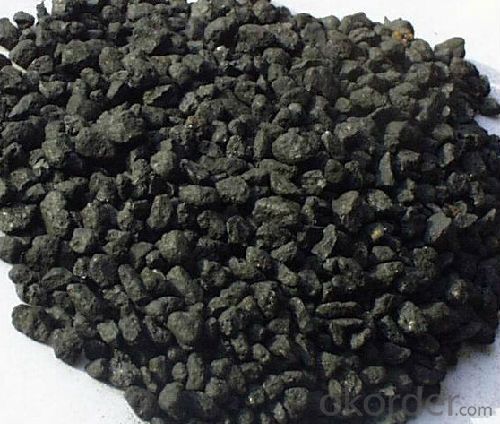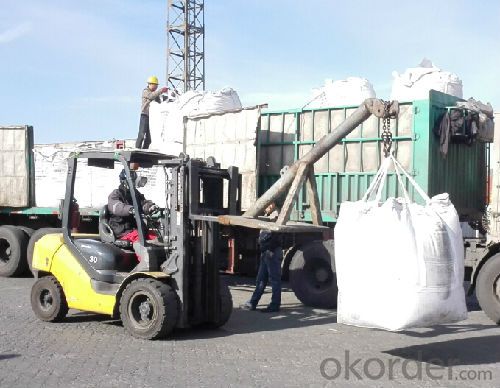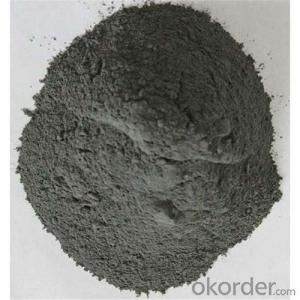Petroleum Coke Price Natural Petroleum Coke CPC Powder
- Loading Port:
- Tianjin
- Payment Terms:
- TT or LC
- Min Order Qty:
- 20 m.t.
- Supply Capability:
- 1500 m.t./month
OKorder Service Pledge
OKorder Financial Service
You Might Also Like
Quick Details
Place of Origin: China (Mainland)
Application: carben additives
Dimensions: fix carben morethan98%,sulphur less5%
Chemical Composition: nature graphite powder
attribute: briquette grade
shape: <SPAN style="BORDER-BOTTOM: 0px; BORDER-LEFT: 0px; PADDING-BOTTOM: 0px; MARGIN: 0px; PADDING-LEFT: 0px; PADDING-RIGHT: 0px; FONT-FAMILY: inherit; WORD-WRAP: break-word; VERTICAL-ALIGN: baseline; BORDER-TOP: 0px; BORDER-RIGHT: 0px; PADDING-TOP: 0px" class=attr-value title=block/powder>block/powder
classify: carbon additives/petroleum coke
Packaging & Delivery
| Packaging Details: | 50kg/bag,25kg/bag or as customer requirement |
|---|---|
| Delivery Detail: | 20DAYS after payment |
Specifications
Petroleum Coke Price Natural Petroleum Coke CPC Powder
Petroleum coke products can be divided into needle coke, sponge coke, projectile coke and coke breeze four kinds.
Calcined Petroleum Coke
F.C.: 98.5%MIN
ASH: 0.8% MAX
V.M.: 0.7%MAX
S:0.5%MAX
Moisture: 0.5%MAX
Structure
Petroleum Coke Price Natural Petroleum Coke CPC Powder
Shape: granule
- Dimensions: 0-1mm, 1-5mm, 1-6mm, 2-8mm, etc
- Product Type: Carbon Additive
- C Content (%): 98-99.5% MIN
- Working Temperature: -
- S Content (%): 0.5%-0.7%MAX
- Ash Content (%): 0.7%MAX
- Volatile:0.8%MAX
- Moisture: 0.5% MAX
- ADVANTAGE: low ash & sulfur
- COLOR: Black
Feature
Petroleum Coke Price Natural Petroleum Coke CPC Powder
Physics and chemistry performance:
Unit | Index | |||||
No.1 | No.2 | No.3 |
| |||
Density | g/cm3 | 2.04 | 2.00 | 2.00 | ||
sulphur content | %≤ | 0.5 | 1.0 | 2.5 | ||
volatility | %≤ | 0.5 | 0.5 | 0.5 | ||
ash content | %≤ | 0.5 | 0.5 | 0.5 | ||
moisture | %≤ | 0.3 | 0.5 | 0.5 | ||
charcoal | %≤ | 98.5 | 98.0 | 98.0 | ||
Image
Petroleum Coke Price Natural Petroleum Coke CPC Powder


FAQ:
Petroleum Coke Price Natural Petroleum Coke CPC Powder
How to classify calcined petroleum coke?
1) According to difference of sulfur content, can be divided into high sulfur coke (sulfur content more than 4%), sulphur in coke sulfur content (2% 4%) and low sulfur coke (sulfur content below 2%).
2) Petroleum coke products can be divided into needle coke, sponge coke, projectile coke and coke breeze four kinds:
3) Needle coke, has obvious needle-like structure and fiber texture, mainly used for steel-making in high power and ultra-high power graphite electrode. As a result of needle coke in sulfur content, ash content, volatile matter and true density and so on have strict quality requirements, so the production process of needle coke and raw materials have special requirements.
4) The sponge coke, high chemical reactivity, low content of impurities, mainly used in the aluminum industry and carbon industry.
5) Focal or spherical coke: the projectile shape is round, diameter 0.6-30 mm, usually from the production of high sulphur, high asphaltic residual oil, can only be used as industrial fuel power generation, cement etc.
6) Coke breeze: fluidized coking process, the fine particles (0.1- 0.4 mm) in diameter, high volatile, high expansion coefficient, cannot be directly used for electrode preparation and carbon industry.
Advantage:
Petroleum Coke Price Natural Petroleum Coke CPC Powder
1. High quality and competitive price.
2. Timely delivery.
3. If any item you like. Please contact us.
Your sincere inquiries are typically answered within 24 hours.
- Q:How do you remove car carbon?
- 3, running high speed can flush carbon deposition? Running high speed, you can really use the airflow on the airway erosion, wash away part of the carbon deposition. So, if you happen to go out, there are high-speed, national road two choices, you may choose to pull back to speed. But, Ma director thinks, if be in order to "flush carbon deposit" specially, want to run high speed, do not have this necessity. "It is a waste of time, and the cost of oil, extra high speed tolls, the effect is better to do a maintenance 4S shop!" 4, improve the shift speed, such as the original speed 2000rpm shift, modified 2500rpm conversion, generated can prevent carbon deposition, but also to protect the engine? Ma director said, low speed the shift, is often said that the "drag block", the car is easy to knock, the combustion of gasoline is not sufficient to carbon deposition. But it's not necessary for people to increase gear speed - that will increase fuel consumption and cause premature wear of clutch friction plates. So, manual transmission of the car, 1.6 ~ 2.0L displacement, about 2000 rpm shift is more economical, and no need to improve; and automatic car, pay attention not to slam the gas.
- Q:Is carbon a conductor?
- Graphite is a conductor, diamond is notGraphite is a layer, C structure can guide electrons, but diamond is stable, C structure can not guide electronsTo see whether a substance is a conductor, the key is to see if it can lead to electrons - - this is an explanation in a middle school book
- Q:What is carbon nanotechnology?
- Carbon nanotechnology is a branch of science and engineering that focuses on the manipulation and study of materials at the nanoscale using carbon-based materials, such as carbon nanotubes and graphene. Nanotechnology, in general, deals with structures and devices at the nanometer scale, which is about 1 to 100 nanometers in size. Carbon nanotechnology takes advantage of the unique properties of carbon to create and control nanostructures with exceptional mechanical, electrical, and chemical properties. Carbon nanotubes, for example, are cylindrical structures made of carbon atoms arranged in a hexagonal lattice. They have remarkable strength, thermal conductivity, and electrical properties due to their unique structure. Carbon nanotubes can be used in a wide range of applications, such as electronics, energy storage, and materials science. They hold great promise for creating stronger and lighter materials, more efficient batteries, and faster and smaller electronic devices. Graphene, another carbon-based material, is a single layer of carbon atoms arranged in a hexagonal lattice. It is known for its exceptional strength, electrical conductivity, and thermal conductivity. Graphene has the potential to revolutionize various industries, including electronics, medicine, and energy. Its properties make it a promising candidate for flexible electronics, high-performance batteries, and even drug delivery systems. Carbon nanotechnology also involves the development of methods to synthesize and manipulate carbon-based nanostructures. Researchers use various techniques like chemical vapor deposition, laser ablation, and molecular self-assembly to create nanoscale carbon materials. These techniques allow for precise control over the size, shape, and properties of the nanostructures, enabling the design of materials with tailored properties for specific applications. In summary, carbon nanotechnology is a field that explores the unique properties and applications of carbon-based materials at the nanoscale. It holds immense potential for revolutionizing various industries and creating new technologies that could benefit society in numerous ways.
- Q:What are the impacts of carbon emissions on the availability of freshwater resources?
- Carbon emissions have a significant impact on the availability of freshwater resources. One of the primary effects is the alteration of the global climate system. Increased carbon emissions lead to the greenhouse effect, which causes global warming. As a result, the Earth's temperature rises, leading to changes in weather patterns and precipitation. These changes in weather patterns can disrupt the water cycle, which crucially affects the availability of freshwater. Warmer temperatures increase evaporation rates, causing more water to be lost from lakes, rivers, and groundwater reservoirs. This leads to a reduction in the overall volume of available freshwater. Furthermore, global warming can exacerbate drought conditions in some regions. As carbon emissions contribute to rising temperatures, the frequency and intensity of droughts increase. This further reduces freshwater availability, as precipitation is limited, and water sources become depleted. Carbon emissions also impact freshwater resources through their effect on melting polar ice caps and glaciers. As the Earth warms, these frozen water sources melt at an accelerated rate, adding additional freshwater to the global water system initially. However, once these ice sources are depleted, the loss of freshwater will be significant. This process not only decreases the overall volume of freshwater available but also affects the quality of freshwater resources, as the melting ice can introduce pollutants and contaminants into the water. Moreover, carbon emissions contribute to ocean acidification, which has indirect effects on freshwater resources. Increased carbon dioxide in the atmosphere is absorbed by the oceans, leading to acidification. This change in the ocean's chemistry can harm marine ecosystems, including coral reefs, which are crucial for maintaining the health of coastal freshwater sources such as aquifers. To mitigate the impacts of carbon emissions on freshwater resources, it is vital to reduce greenhouse gas emissions and transition towards cleaner and renewable energy sources. Additionally, implementing effective water management practices, such as conservation measures, efficient irrigation systems, and the protection of water sources, can help preserve and sustain freshwater resources in the face of climate change and carbon emissions.
- Q:What is the role of carbon 60 in industry? Can it be interchanged with the chemical properties of carbon? What is the chemical structure of carbon 60?
- Used to strengthen metals; used as a new catalyst for storage of gases
- Q:How are carbon-based polymers synthesized?
- Carbon-based polymers are synthesized through a process known as polymerization. This involves the chemical reaction of monomers, which are small molecules, to form long chains of repeating units, known as polymers. Carbon-based polymers, also known as organic polymers, are composed of carbon atoms bonded together in a backbone structure. There are various methods for synthesizing carbon-based polymers, but the most common one is called addition polymerization. In this process, monomers with unsaturated carbon-carbon double bonds, such as ethylene or propylene, undergo a reaction called addition polymerization. This reaction is initiated by a catalyst, which can be heat, light, or a chemical initiator, and it causes the monomers to join together, forming a polymer chain. Another method for synthesizing carbon-based polymers is condensation polymerization. In this process, two different types of monomers react with each other, eliminating a small molecule, such as water or alcohol, as a byproduct. The remaining monomers then continue to react, forming a polymer chain. Examples of polymers synthesized through condensation polymerization include polyesters and polyamides. In addition to these methods, there are also other techniques used to synthesize carbon-based polymers, such as ring-opening polymerization, which involves the opening of cyclic structures to form linear polymer chains, and step-growth polymerization, which involves the reaction of two or more monomers with reactive end groups. Overall, the synthesis of carbon-based polymers involves the combination of monomers through various chemical reactions to form long chains of repeating units. These polymers have a wide range of applications in industries such as plastics, textiles, and electronics, due to their desirable properties such as strength, flexibility, and thermal stability.
- Q:What are the benefits of carbon-neutral technologies?
- Carbon-neutral technologies have numerous benefits, including the reduction of greenhouse gas emissions, mitigating climate change, and improving air quality. They also promote energy efficiency, stimulate innovation and job creation in the clean energy sector, and enhance energy security by reducing reliance on fossil fuels. Furthermore, carbon-neutral technologies contribute to sustainable development, foster international cooperation, and create a healthier and more sustainable future for all.
- Q:How does carbon impact the prevalence of earthquakes?
- Carbon does not directly impact the prevalence of earthquakes. Earthquakes are primarily caused by the movement of tectonic plates and the release of built-up stress along fault lines. However, carbon emissions and climate change can indirectly affect the frequency and intensity of earthquakes by contributing to the melting of glaciers and polar ice caps, which in turn can lead to changes in the Earth's crust and the redistribution of its mass. These changes can potentially influence the occurrence of seismic activities.
- Q:Is the power consumption of carbon fiber heating very high?
- Power consumption calculation:The information you give is not enough to calculate the approximate power consumption!You also need to know your building structure, insulation level, the laying power of electric heating, personal use, setting temperature, local temperature difference between indoor and outdoor, control device is intelligent temperature control and so on!There is also the first heating season, because the building is humid, the electricity consumption will be higher!How to save electric energyIf you want to save electricity, you need it:Give the building a good heat insulation,Use double or three layers of glass,Intelligent temperature controller, and according to the rules of personal life to set, make full use of energy saving, and these are not to reduce somatosensory comfort conditions,The carbon fiber heating cable laying and electric heating, far infrared ray to human body temperature will be higher, also need 18 degrees of comfort, the use of carbon fiber electric heating heating cable only need to set at 16 degrees, so the temperature can be, 2 DEG C, and the temperature difference is small at the only Province 2 C energy, in fact is not the case, as we all know, small temperature difference, the indoor temperature is more easy to maintain!Apply the peak and valley tariff to the local electricity department, so that the electricity price will be around 0.35 yuan at night, and the temperature will be greater at home and in the evening, which will save a lot of money!Do all of this and I'm sure you'll save 20% of your electricity bill!Poly Jiao carbon fiber heating cable electric heating - for you, we are more professional
- Q:How are carbon markets regulated?
- Carbon markets are regulated through a combination of international, national, and regional frameworks that aim to ensure the integrity and transparency of emissions trading. One of the main international bodies overseeing carbon markets is the United Nations Framework Convention on Climate Change (UNFCCC), which established the Kyoto Protocol and the Paris Agreement. Under the Kyoto Protocol, an international emissions trading system was created, allowing countries to trade emission allowances through the Clean Development Mechanism (CDM) and Joint Implementation (JI) projects. The CDM and JI projects are approved and monitored by the UNFCCC, which ensures that emission reductions are real, measurable, and additional to what would have occurred without the project. The Paris Agreement, which succeeded the Kyoto Protocol, introduced a new market mechanism called the Sustainable Development Mechanism (SDM). The SDM aims to promote sustainable development and help countries achieve their climate goals by enabling emission reductions and removals through projects in developing countries. At the national and regional level, governments and regulatory bodies play a crucial role in the regulation of carbon markets. They establish legal frameworks, set emission reduction targets, and develop domestic emissions trading systems. These systems typically involve the allocation of emission allowances to companies or sectors, monitoring and reporting of emissions, and the trading of allowances on regulated platforms. To ensure the integrity of carbon markets, strict regulations are put in place to prevent fraud, double-counting, and other forms of market manipulation. Independent verification and accreditation bodies are responsible for auditing emissions data and project methodologies to ensure compliance with the established rules and standards. Furthermore, market oversight and enforcement bodies are established to monitor and enforce compliance with the regulations. These bodies have the authority to investigate and penalize any non-compliance, including imposing fines or revoking emission allowances. Overall, the regulation of carbon markets involves a complex network of international agreements, national legislation, and regulatory bodies. The aim is to create a robust and transparent market that incentivizes emission reductions and supports the transition to a low-carbon economy.
1. Manufacturer Overview |
|
|---|---|
| Location | |
| Year Established | |
| Annual Output Value | |
| Main Markets | |
| Company Certifications | |
2. Manufacturer Certificates |
|
|---|---|
| a) Certification Name | |
| Range | |
| Reference | |
| Validity Period | |
3. Manufacturer Capability |
|
|---|---|
| a)Trade Capacity | |
| Nearest Port | |
| Export Percentage | |
| No.of Employees in Trade Department | |
| Language Spoken: | |
| b)Factory Information | |
| Factory Size: | |
| No. of Production Lines | |
| Contract Manufacturing | |
| Product Price Range | |
Send your message to us
Petroleum Coke Price Natural Petroleum Coke CPC Powder
- Loading Port:
- Tianjin
- Payment Terms:
- TT or LC
- Min Order Qty:
- 20 m.t.
- Supply Capability:
- 1500 m.t./month
OKorder Service Pledge
OKorder Financial Service
Similar products
New products
Hot products
Hot Searches
Related keywords






























